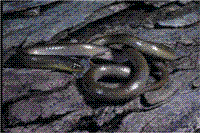Family
Pygopodidae (legless lizards)
Genus
Delma
Species
inornata
Threats/Control Methods - Regional
On-farm reduction in habitat features (such as logs and other debris) is a threat to regional populations of the Olive Legless Lizard.
Threats/Control Methods - Local
Urban expansion into areas of previous habitat threatens local populations of the lizard.
Local/Urban Actions
Research has been conducted that suggests that artificial refuges can be beneficial to populations of the Olive Legless Lizard (Michael et al. 2004). Therefore, to increase habitat for the species in urban parklands and gardens, placement of logs may increase the numbers of the legless lizard.
Common name/s
Olive Legless Lizard, Plain Snake-Lizard, Inornate Legless Lizard
Distinguishing Features
Delma inornata is a lizard (not a snake), but it does not have legs. It is grey to olive brown in colour, often with a yellow throat. Generally, the lizard has no patterning in its scales. The Olive Legless Lizard has a very long tail and scaly flaps instead of hind limbs. Its total length is approximately 40cm. The females of the species are substantially larger than the males.
Similar Species
The Striped Legless Lizard (Delma impar ) is similar in appearance, but has patterned scales, with stripes running down the length of its body and tail. Legless lizards are often mistaken for snakes and are sometimes killed as a result. However, the two species of legless lizards in the ACT do not resemble any snakes in the area. Legless lizards have ear openings and a fleshy tongue (not forked) which snakes do not have.
Distribution
The lizard is widespread from south-eastern Queensland, through New South Wales and Victoria to eastern South Australia. Found in inland areas from the Great Dividing Range to the arid interior. In the ACT, the lizard is found in the undulating country to the north of the territory.
Country of Origin
Australia
Survey Techniques
Pitfall trapping and hand searching
Conservation (Pet/Pest) Status - National
Not considered at risk
Conservation (Pet/Pest) Status - Regional
Olive Legless Lizards may be kept in the ACT by people very experienced in keeping reptiles. The species is quite common in the northern areas of the ACT.
LSCCES Population
Unknown
Associated vegetation community
Grasslands and woodlands.
Limiting Resources
The Olive Legless Lizard requires suitable habitat, including dry shelter areas.
Breeding
The Olive Legless Lizard lays two eggs in summer.
Behaviour
The lizard shelters under stones, tussock grasses, logs and even sheets of metal. It is not found in wetter areas. It is diurnal.
Functional Group
Insectivore
Food Species
The Olive Legless Lizard feeds mainly on grasshoppers and crickets, but also eat spiders.
Predators
Foxes (Vulpes vulpes) and cats (Felis domesticus).
Interesting Fact
Legless lizards are most closely related to geckos. Like geckos, they lick their eyes.
References - (reader suitability of references, P=Primary teachers, S=Secondary students, T=Tertiary students and researchers)
Books:
Bennett, R. 1997. Reptiles & Frogs of the Australian Capital Territory, National Parks Association of the ACT, Woden. P, S
Swan, G., Shea, G. and Sadlier, R. 2004. A Field Guide to Reptiles of New South Wales, Second Edition, Reed New Holland, Sydney. P, S, T
Wilson, S. and Knowles, D. 1988. Australia's reptiles, Collins Publishers, Australia. S, T
Journal Articles:
Michael, D.R., Lunt I.D. and Robinson, W.A. 2004. "Enhancing fauna habitat in grazed native grasslands and woodlands: use of artificially placed log refuges by fauna" in Wildlife Research. Vol 31, pp. 65-71. www.publish.csiro.au/?act=view_file&file_id=WR02106.pdf[Last accessed 6/3/2007] T
Patchell, F.C.and Shine, R. 1986. "Food Habits and Reproductive Biology of the Australian Legless Lizards (Pygopodidae)" in Copeia, 1986(1), pp. 30-39. T
Internet:
Environment ACT (2006). "Reptile Policy ". Last updated 15/9/2006.http://www.environment.act.gov.au/nativeplantsandanimals/licensingplantsandanimals/repplcy2/keeprep2[Last accessed 6/3/2007] S, T
Researchers: Ian Rayner and Adam Houlden

 Top
Top Top
Top